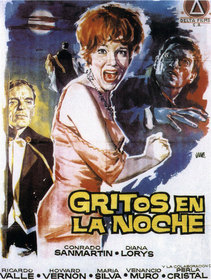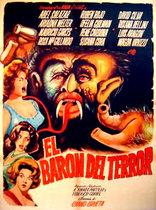Our editor-in-chief Nate Yapp is proud to have contributed to the new book Hidden Horror: A Celebration of 101 Underrated and Overlooked Fright Flicks, edited by Aaron Christensen. Another contributors include Anthony Timpone, B.J. Colangelo, Dave Alexander, Classic-Horror.com's own Robert C. Ring and John W. Bowen. Pick up a copy today from Amazon.com!
The Awful Dr. Orlof (1962)
Whether you believe that prolific multi-hyphenate Jesus Franco, director of over 150 films and writer, co-star, or composer of many of them, is an irritating hack or a secret genius, you have to respect his 1962 film, The Awful Dr. Orlof. You may not admire it, although I certainly do, but its place in film history is set. The first “true” horror movie produced in Spain, The Awful Dr. Orlof is a flash point in the turbulent transition of the horror film from the Gothic to the modern.
The story about how The Awful Dr. Orlof (original title Gritos en la Noche or Screams in the Night) came to be is, in itself, fascinating. Franco, already four features into his directing career, was prepping his next movie, which was based on a Central American story that the filmmaker had known all of his life. However, Spain and Spanish cinema was under the control of Generalissimo Francisco Franco at the time; the state censors rejected the project on political grounds. However, the cast was already contracted, so Franco had to come up with another film on the double. One trip to see Hammer's Brides of Dracula later, Franco and his producers were discussing a new direction.1 Franco furiously wrote up a horror script, and, because it had absolutely no political content whatsoever, was able to get it approved. There's some small irony there – censorship, typically the bane of horror, was the impetus behind the creation of Spain's horror industry.
The Awful Dr. Orlof's storyline resembles what Georges Franju's surgical horror, Eyes Without a Face, might look like if penned by British mystery writer Edgar Wallace (although Franco claimed not to have seen Franju's film prior to writing Orlof2). In the shadowy streets of a turn-of-the-century European city (which one and which country are never clear, as the names used are fictional), beautiful women are going missing. Dr. Orlof (Howard Vernon, a frequent Franco player from here on out), assisted by the blind, brutish Morpho (Ricardo Valle), has been taking these fresh specimens for their skin, so he can use it to repair the scarred face of his darling daughter (Diana Lorys). Meanwhile, Inspector Tanner (Conrado San Martin) uses all of his detective wiles to discover the fiends behind the disappearances, a task which takes him away from his ballerina girlfriend Wanda (also Lorys). Determined to help her boyfriend, Wanda sets herself as bait for Orlof, which goes about as well as you'd expect.
Franco decorates Orlof with the usual, expected elements you would find in many of the Gothic horror films from the first half of the twentieth century. Dr. Orlof lives in an enormous castle with giant stone staircases, works in a typical laboratory equipped for mad science, and has a hulking manservant who does his horrible bidding. In the city, our hero and his damsel ride in horse-drawn carriages down twisty cobblestone streets. Whenever there is a hint of danger, you can be sure to find that old, reliable chiaroscuro lighting casting shadows everywhere. Viewing a series of stills from Orlof, one could conceivably make the mistake that the film is simply just another mad doctor chestnut from the 1940s. After watching the movie, however, they'd see how wrong they were.
While the notes in Orlof are familiar, the arrangement is brand-new. The camera is not a staid observer of actions, moving from long-shot to medium-shot to close-up and back again. Neither is it a roving force standing in for some unseen evil. The camera exists within the film and has a personality all of its own, a keenly involved party with a short attention span. A woman screams in an empty house, and the camera cuts to all the places her voice travels. A man enters a room, and the zoom lens moves in on him, winnowing out all the parts of the shot that are no longer interesting. A sexy music hall chanteuse works her magic in a skimpy costume, and the shot leers. Close-ups are always a little too close, pans are a bit too fast, shots are skewed slightly off-center, and that zoom is way more active than it has any right to be. It's marvelous, absolutely marvelous. Franco's direction, however, isn't the only aspect of Orlof that defies the general horror conventions of the period.
The audio elements of Orlof complement the visuals, combining efforts to keep the audience on their toes. The dizzy musical score by José Pagán and Antonio Ramírez Ángel... Actually, I misspeak – “music” is far too nice a word for the cacophony of percussion and bizarre arrangements that permeate Orlof's soundscape. Pagán and Ángel's work is more of a thrumming wakeup call to the senses, a bucket of cold water tossed down the ear. The camerawork and the soundtrack combine to form a general aesthetic of “screw aesthetics,” infusing Orlof with a manic, exhilarating energy that enlivens and rejuvenates the clichés in the script.
This is not to say that the script itself does not benefit from this reconfiguration of standards, because it does. The characters may be based on certain archetypes, but some of the relationships have shifted into new directions. Specifically, Dr. Orlof has a different way of looking at his victims; he looks at them with pure lust. Orlof's mission is to acquire beautiful women, and he takes it quite seriously. He frequently scopes out potential skin donors from a box seat at the music hall, watching from above with eyes that don't seem to miss a single jiggle of the cleavage or toss of the hair (Vernon is particularly good at selling this aspect of the character). Taking drinks with these gorgeous ladies, he constantly comments on their beauty and their perfect skin, but never spends a moment even pretending to be interested in their personalities. Gone is the pretense of the madman so overcome by the beauty of the heroine that he falls for her – now that same beauty is a death sentence. Sex and sexuality are dangerous things to have, the film says, and many movies made since repeat that mantra, for better or worse.
In the five year period after The Awful Dr. Orlof was released, horror accounted for thirteen of Spain's movie productions or co-productions. In the five year period after that, that number more than tripled. One wonders if those films – among them The House That Screamed, Tombs of the Blind Dead, Werewolf Shadow and Franco's own The Diabolical Dr. Z – would have existed in the form we know them today without that first unorthodox step by Jesus Franco. I'm grateful that I'll never have to find out.
This review is part of Spanish Horror Week, the second of five celebrations of international horror done for our Shocktober 2008 event.








